 |
 |
 |
 |
 |
 |
 |
 |
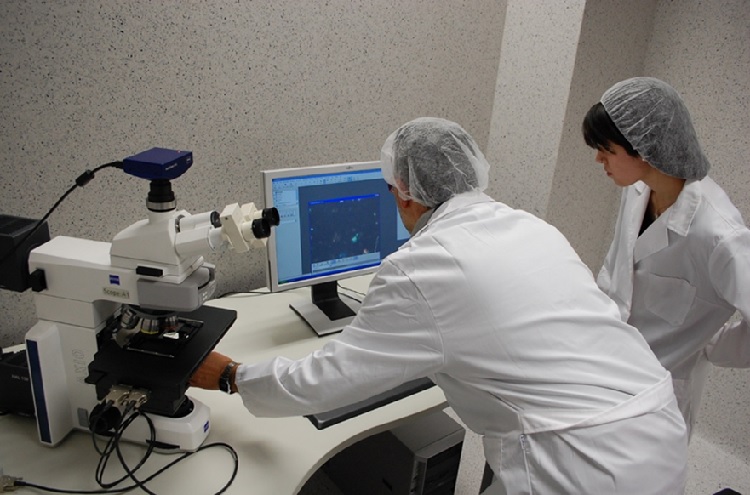
INSTITUTE OF SPACE SCIENCES (CSIC-IEEC) METEORITE CLEAN LABORATORY
CHARACTERIZATION OF METEORITES AND SPACE RETURNED SAMPLESThe Institute of Space Sciences (CSIC-IEEC) has a clean room serving as petrographic laboratory for the Meteorites, Minor Bodies and Planetary Sciences group (PI. Dr. Trigo-Rodríguez), where we study and characterize meteorites, and returned samples from space missions (e.g. Stardust and Hayabusa). We host a meteorite collection, and our research institute is an international repository of NASA Antarctic Meteorites arrived from the Johnson Space Center. At the Institute of Space Sciences (CSIC-IEEC) we have state-of-the-art instrumentation to study meteorites and returned samples under clean laboratory conditions. We also cooperate with other researchers in order to apply new research techniques to get insight on these fascinating rocks arrived from distant locations of our Solar System. In particular, we study the bulk chemistry, mineralogy, and other physico-chemical properties of thick and thin sections of the samples arrived to our clean laboratory. A Zeiss Scope petrographic microscope is used to study carefully the thin sections of the samples and perform accurate measurements.
As CSIC professional researchers and members of the Meteoritical Society with dilated experience in analytical techniques we are leading experts in meteorite characterization. In fact, we have named the last meteorite falls occurred in Spain (Ardón, Puerto Lápice and Villalbeto de la Peña) plus others meteorites fell recently in South America like e.g. Berduc and Cali, among others also found. We characterize the meteorites using the most modern instrumental techniques that allow us to infer if the studied rock is a meteorite or not, and to classify it accordingly the known meteorite classes and groups. We are experts in chondrites, rocks arrived from asteroids, but also working in achondrites reaching the Earth from planetary bodies. In fact, as demonstrated in our publications in first quartile journals, we have characterized chondrites arrived to Earth from asteroids and achondrites from Mars, the Moon, or Vesta, for example. Our group is also specialized in aqueous alteration in meteorites, so we infer the action of water in the parent bodies of the meteorites, before the rock arrived to Earth. One of our research goals is defining the pathways in which the water was delivered to our planet. 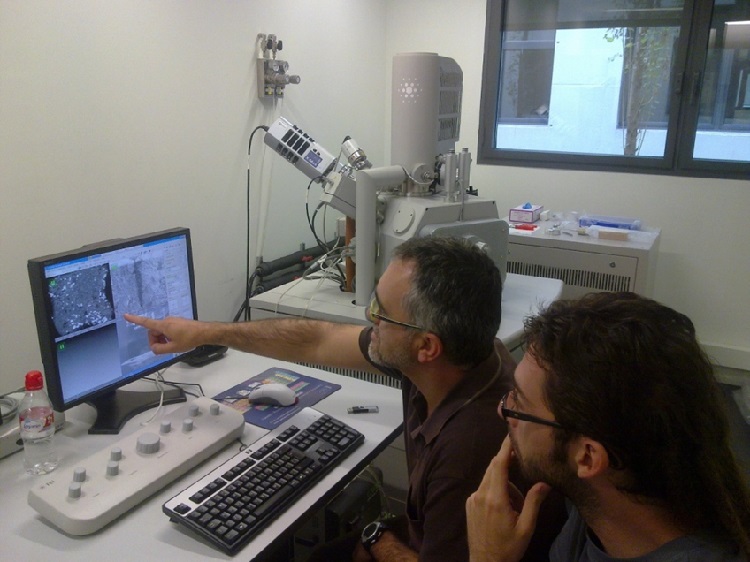
Dr. Trigo-Rodríguez and Dr. Moyano-Cambero studying Chelyabinsk ordinary chondrite at CIN2-CSIC.RESEARCH TECHNIQUES TO STUDY METEORITES AND RETURNED SAMPLESThe incorporation of Dr. Trigo-Rodríguez to the Institute of Space Sciences (CSIC-IEEC) in 2006 after a 3 years postdoc at the University of California Los Angeles (UCLA) allowed our center to apply many of the research techniques used by the famous IGPP meteorite group lead by Prof. John Wasson (group originally classifying the chondrites), but also explore other techniques with CSIC-UAB-UPC experts in science of materials. Among the instrumental techniques currently used by our group in Barcelona to characterize meteorites and returned samples, and citing just those in which our group has dilated expertise, we cite:
Institute of Space Sciences (CSIC-IEEC) research lines are focused in the study of the so-called cosmic cycle. Our research group focuses on the formation conditions of the first solids, the physico-chemical processes forming asteroids and comets and the hazard associated with these bodies. Our research institute is specialized in space missions, and our group has beeing part of several ones. For example, in our laboratory we have studied particles of comet 81P/Wild 2 returned by Stardust NASA mission. On the other hand, we studied the physico-chemical properties of regolith samples collected by JAXA Hayabusa mission of asteroid 25143 Itokawa. We are applying state-of-the-art techniques to infer the strength and chemical composition of the samples in view of gaining knowledge for future missions like the Double Asteroid Redirection Test (DART) NASA mission. In particular, we performed a seminal study of the mechanical properties of Itokawa's regolith in the framework of improving our ability to deflect asteroids in the framework of DART and the Hera ESA mission.
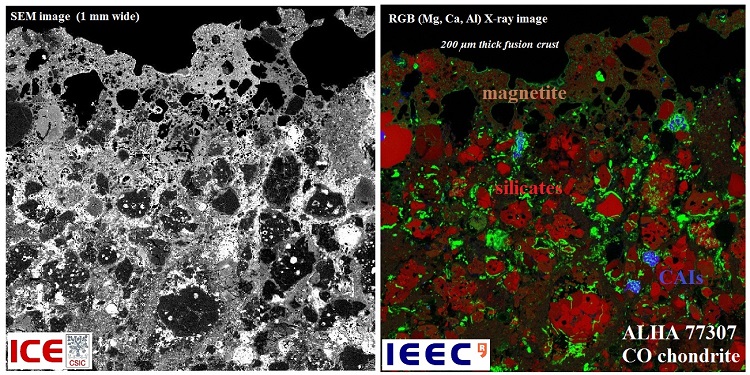
A mm square window of the pristine CO carbonaceous chondrite ALHA77307 seen through electron microscope. A BSE image is on the left, while on right is a X-Ray image to distinguish the main rock-forming chemical elements: (Red: Mag, Green: Ca, Blue: Al) that are in form of magnetite and silicates. The fusion crust is about 200 microns in thickness (Trigo-Rodríguez/CSIC-IEEC).DO YOU THINK YOU HAVE A METEORITE? THEN, CONTACT US!
It is usual that you find a "weird" rock walking around and you think that it might be a meteorite. Well, we must first say that such a lucky finding is certainly difficult as meteorites are quickly weathered being in the Earth's surface. Many terrestrial rocks are altered by the action of the elements and produce the so called meteorwrongs, but certainly we can find it out together. As we are really expert in meteorites, we can easily distinguish if you really have a meteorite from a picture or, sometimes, from visual inspection. In positive case, we will perform for you an official classification FOR FREE, but we certainly decide first which specimens to study, case by case. We give priority to fresh meteorites arrived from recent falls under study by our Spanish Fireball Network, but findings can also be of interest to us.
Please note that we are not moved by any economical interest, as we basically want to promote meteorite studies and make the specimens accessible to study by our colleagues and young researchers, at the same time that we inform the owners to make the meteorites enjoyable to the public in museums. Be aware that to classify a meteorite we need a sample of the rock of at least one cubic centimeter to study its petrology, mineralogy and bulk chemistry using different state-of-the-art techniques. We often start by making a thin section to be studied through our microscopes. As we perform the classification at not cost, that specimen offered to our lab is kept for classication purposes and to act as hosting institution for the Meteoritical Society (any new named meteorite should have an institution where samples are available to study by the international community). We remark that, except that sample offered us for study, the rest of the meteorite belongs to the owner. Obviously, in the case of fresh meteorites we certainly inform the owners that in Spain the meteorites are part of Geologic Patrimony since the 42/2007 Law. After all, only counting with the collaboration of everyone we will preserve these unique rocks for future generations of scientists and science enthousiasts. In case that you think you have a possible meteorite please send a couple of high-resolution images of the rock to the Meteorite and Sample Return Laboratory (CSIC-IEEC).
ACKNOWLEDGMENTS AND FUNDING SOURCES.This ongoing research on Meteoritica at CSIC-IEEC wants to be example of cooperation with other research groups around the world. Our research publications exemplify the way in which we understand collaborative science, also involving PhD students and early carrier ICE researchers. In particular, we offer to the community the identification and classification of meteorites in Spain because our research has been funded in a continuous way through three consecutive research projects lead by our PI Prof. Dr. Trigo-Rodríguez: AYA2011-26522, AYA2015-67175-P y PGC2018-097374-B-I00 (FEDER/Ministerio de Ciencia e Innovación y Agencia Estatal de investigación). In the last decade three PhD theses have been defended with the highest rates of scientific excellence. We have being also funded by the European Space Agency (ESA) to plan specific programs and related experiments in the framework of space missions.
GALLERY OF SELECTED IMAGES
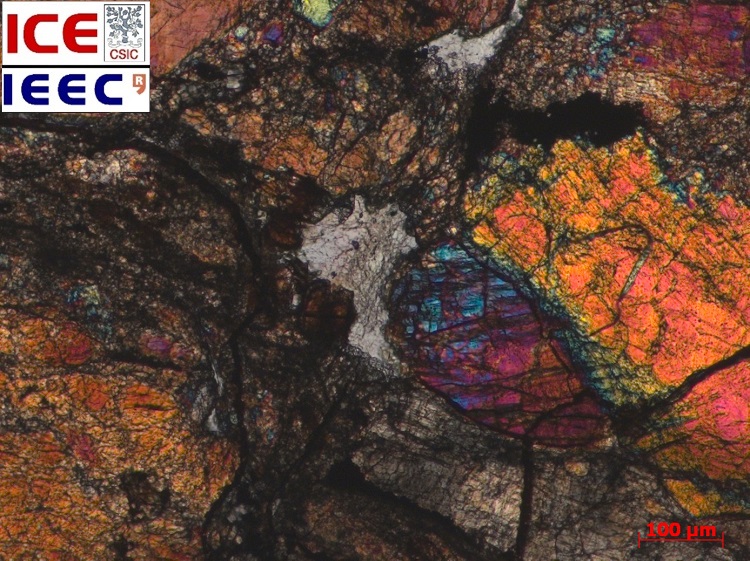
A transmitted image of the famous Martian meteorite Allan Hills 84001 seen through our Zeiss petrographic microscope. Brown coloured carbonate globules are close to the center-left, and the orange colours are characteristic of the pyroxenes dominating the rock (Trigo-Rodríguez/CSIC-IEEC).
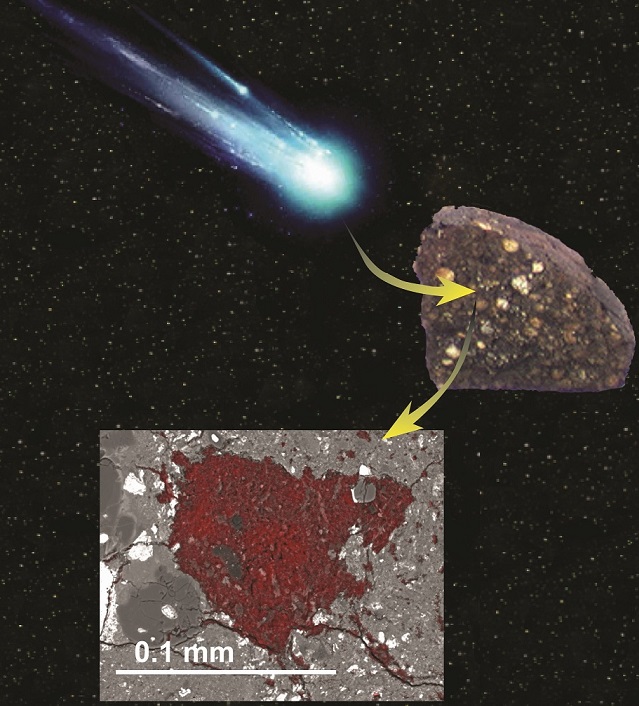
Among the most remarkable discoveries made in our lab is a one hundred microns thick carbon-rich clast in the NASA Antarctic chondrite La Paz 02342 (Larry Nittler and Trigo-Rodríguez/CSIC-IEEC).
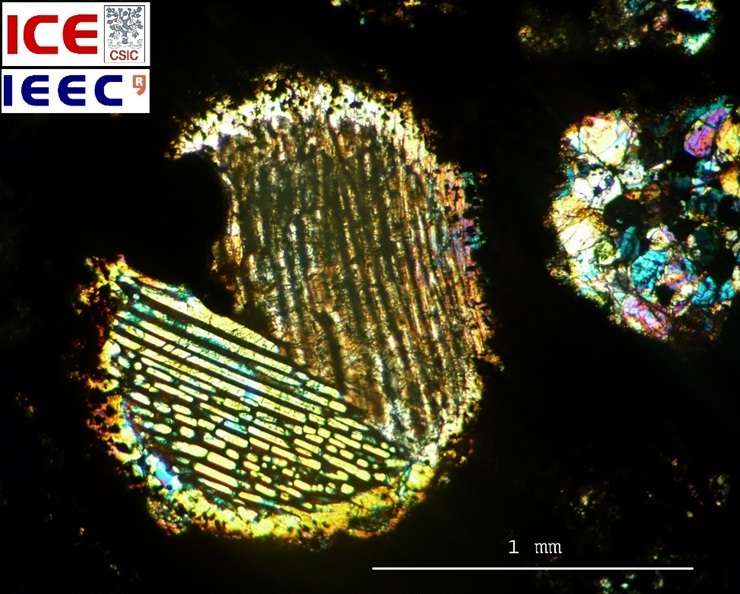
An example of thin section of CV3 carbonaceous chondrite Allende as seen in transmitted light through the Zeiss petrographic microscope. A barred olivine chondrule and another porphiritic one are shown (Trigo-Rodríguez/CSIC-IEEC).
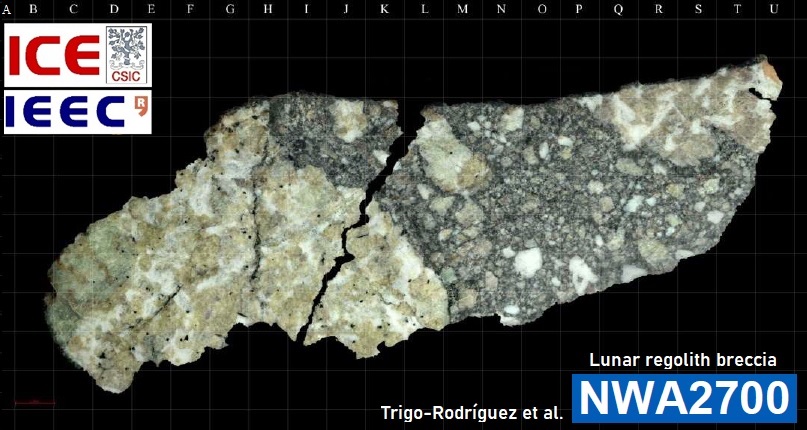
An example of thick section mosaic of Lunar breccia NWA 2700 as seen in reflected light through the Zeiss petrographic microscope (Trigo-Rodríguez/CSIC-IEEC). The grid is 1 mm wide.
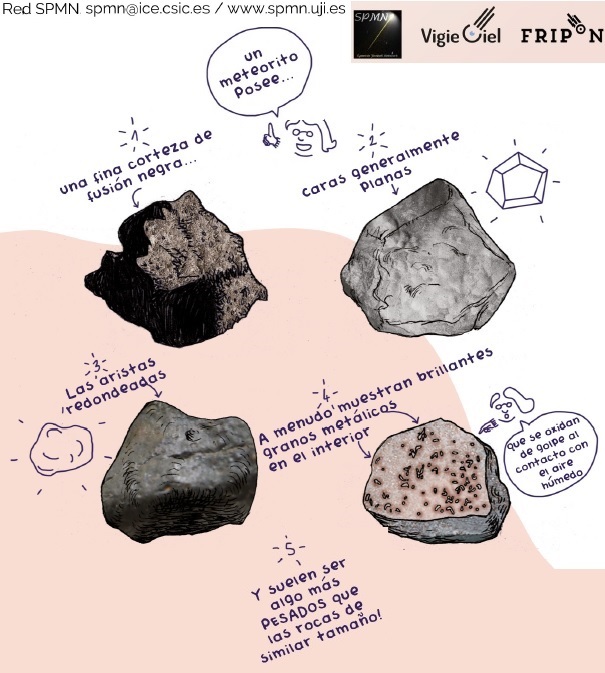
HOW TO RECOGNIZE A METEORITE? Remember that the meteorites possess a number of distinctive features. First a thin black crust of fusion, the faces generally flat, the edges rounded by friction with the atmosphere at hypervelocity and, when they arrive split or show us their interior, they present metallic grains. For the latter, meteorites are much heavier than terrestrial rocks that, in general, do not contain iron. We do not recommend any type of test that destroys or alters the sample in any way, nor subject them to a magnet so as not to alter their primordial magnetic field (Adapted from FRIPON/Red SPMN, in Spanish).
PEER-REVIEWED METEORITE-RELATED PUBLICATIONS OF OUR RESEARCH LABORATORY (Here you can find all our publications):
Tanbakouei S., Trigo-Rodríguez J.M., Llorca, J., Moyano-Cambero C.E., Williams, I.P., and Rivkin A.S. (2021) "The Reflectance Spectra of CV-CK Carbonaceous chondrites from the Near Infrared to the Visible", Monthly Notices of the Royal Astronomical Society, stab2146, 14 pp.
Cabedo V., Llorca J., Trigo-Rodríguez J.M., Rimola A. (2021) "Study of Fischer-Tropsch Type reactions on chondritic meteorites", Astronomy & Astrophysics 650, A160, 23 pp.
Tanbakouei S., Trigo-Rodríguez J.M., Blum, J., Williams, I.P., and Llorca, J. (2020) Comparing the reflectivity of ungrouped carbonaceous chondrites with that of short period comets like 2P/Encke, Astronomy & Astrophysics 641, A58, 7 pp.
Tanbakouei S., Trigo-Rodríguez J.M., Sort, J., Michel, P., Blum, J., Nakamura, T. and Williams, I. (2019) Mechanical properties of particles from the surface of asteroid 25143 Itokawa, Astronomy & Astrophysics 669, A119, doi: https://doi.org/10.1051/0004-6361/201935380, 5 pp.
Trigo-Rodríguez, J.M., Rimola, A., Tanbakouei, S., Cabedo-Soto, V., and Lee, M. R. (2019) "Accretion of water in carbonaceous chondrites: current evidence and implications for the delivery of water to early Earth", Space Science Reviews 215:18, 27 pp.
Martínez M., A. Brearley, J. M. Trigo-Rodríguez J.M., and J. Llorca (2019) “New observations on high-pressure phases in a shock melt vein in the Villalbeto de la Peña meteorite: Insights into the shock behavior of diopside”, Meteoritics and Planetary Science 54, 2845-2863.
Nittler L.R., Stoud, R.M., Trigo-Rodríguez, J.M., De Gregorio B.T., Alexander C.M.O'D., Davidson J., Moyano-Cambero C.E., and Tanbakouei, S. (2019) "A cometary building block in a primitive asteroidal meteorite", Nature Astronomy, doi: 10.1038/s41550-019-0737-8, 8 pp.
Rimola A., Trigo-Rodríguez, J.M., and Martins, Z. (2017) "Interaction of organic compounds with chondritic silicate surfaces. Atomistic insights from quantum chemical periodic simulations", , Phys. Chem. Chem. Phys., 19, 18217-18231.
Moyano-Cambero, C.E., Trigo-Rodríguez, J.M., Benito, M.I., Alonso-Azcárate, J., Lee, M. R., Mestres, N., Martínez-Jiménez, M.; Martín-Torres, F.J., and Fraxedas, J. (2017) "Petrographic and geochemical evidence for multiphase formation of carbonates in the Martian orthopyroxenite Allan Hills 84001", Meteoritics & Planetary Science 52, 1030-1047.
Kohout, T. et al.[including: Trigo-Rodriguez, J.M., Moyano-Cambero, C.E.](2017) "Annama H chondrite—Mineralogy, physical properties, cosmic ray exposure, and parent body history", Meteoritics and Planetary Science 52, 1525-1551.
Rotelli L., Trigo-Rodríguez J.M., Moyano-Cambero C.E., Carota E., Botta L., Di Mauro E. and Saladino R. (2016) "The key role of meteorites in the formation of relevant prebiotic molecules in a formamide/water environment" , Nature Scientific Reports, 6:38888, DOI: 10.1038/srep38888 (selected to be open access).
Moyano-Cambero C.E., Trigo-Rodríguez J.M., Llorca J., Fornasier S., Barucci M.A., and Rimola A. (2016) "A plausible link between the asteroid 21 Lutetia and CH carbonaceous chondrites" , Meteoritics & Planetary Science 51, 1795-1812.
Trigo-Rodríguez J.M., Llorca J., Weyrauch M., Bischoff A., Moyano-Cambero C.E., Keil K., Laubenstein M., Pack A., Madiedo J.M., Alonso-Azcárate J., Riebe M., Wieler R., Ott U., Tapia M. and Mestres N. (2014) "The Ardón L6 ordinary chondrite: A long hidden Spanish meteorite fall" , Meteoritics & Planetary Science 49:8, 1475-1484.
Trigo-Rodríguez J.M., Moyano-Cambero C.E., Llorca J., Fornasier S., Barucci M.A., Belskaya I., Martins Z., Rivkin A.S., Dotto E., Madiedo J.M., and Alonso-Azcárate J. (2014) "UV to far-IR reflectance spectra of carbonaceous chondrites. I. Implications for remote characterization of dark primitive asteroids targeted by sample-return missions" , Monthly Notices of the Royal Astronomical Society 437, 227-240.
Trigo-Rodríguez J.M., J. Llorca, J.M. Madiedo, G. Tancredi, W.N. Edwards, A. E. Rubin, and P. Weber (2010) "The Berduc L6 chondrite fall: Meteorite characterization, trajectory, and orbital elements" , Meteoritics & Planetary Science 45, 383-393.
Trigo-Rodríguez J.M. and J. Blum (2009) The effect of aqueous alteration and metamorphism in the survival of presolar silicate grains in chondrites, (astro-ph link) , Publications of the Astronomical Society of Australia 26(3), 289-296 (DOI: 10.1071/AS08070).
Trigo-Rodríguez J.M., J. Borovicka, J. Llorca, J.M. Madiedo, J. Zamorano, and J. Izquierdo (2009) Puerto Lapice eucrite fall: strewn field, physical description, probable fireball trajectory, and orbit, Meteoritics and Planetary Science 44:4, 175-186.
Llorca J., I. Casanova, J.M. Trigo-Rodríguez , J.M. Madiedo, J. Roszjar, A. Bischoff, U. Ott, I. Franchi, R. Greenwood, and M. Laubenstein (2009) The Puerto Lapice eucrite, Meteoritics and Planetary Science 44:4, 159-174.
Trigo-Rodríguez J.M., J. Llorca, A.E. Rubin, J.N. Grossman, D.W.G. Sears, M. Naranjo, S. Bretzius, M. Tapia, and M. H. Guarin Sepulveda (2009) The Cali meteorite fall: a new H/L ordinary chondrite , Meteoritics and Planetary Science 44:4, 211-220.
Trigo-Rodríguez J.M. , G. Domínguez, M. J. Burchell, F. Hörz, and J. Llorca (2008) “Bulbous tracks arising from hypervelocity capture in aerogel”, Stardust Special Issue, Meteoritics and Planetary Science 43, 23-40.
Rubin A.E., J.M. Trigo-Rodríguez, H. Huber, and J. T. Wasson (2007) Progressive aqueous alteration of CM carbonaceous chondrites. Geochimica et Cosmochimica Acta 71, 2361-2382.
Trigo-Rodríguez J.M., A. Rubin, J.T. Wasson (2006) Non-nebular origin of dark mantles around chondrules and inclusions in CM chondrites . Geochimica et Cosmochimica Acta 70, 1271-1290.
Trigo-Rodríguez J.M., J. Borovicka, P. Spurny, J.L. Ortiz, J.A. Docobo, A.J. Castro-Tirado and J. Llorca (2006) The Villalbeto de la Peña meteorite fall: II. Determination of atmospheric trajectory and orbit , Meteoritics & Planetary Science 41, 505-517.
Llorca J., J.M. Trigo-Rodríguez, J.L. Ortiz, J.A. Docobo, J. Garcia-Guinea, A.J. Castro-Tirado, A.E. Rubin, O. Eugster, W. Edwards, M. Laubenstein and I. Casanova (2005) The Villalbeto de la Peña meteorite fall: I. Fireball energy, meteorite recovery, strewn field and petrography , Meteoritics & Planetary Science 40, 795-804.
Rubin A., J.M. Trigo-Rodríguez, T. Kunihiro, G.W. Kallemeyn and J.T. Wasson (2005) Carbon-rich chondritic clast PV1 from the Plainview H-chondrite regolith breccia: formation from H3 chondrite material by possible cometary impact, Geochimica et Cosmochimica Acta 69, 13, pp.3419-3430.
| |||